An Introduction to Human Biology
1 Organizing Concepts
Themes in Human Biology
Learning Objectives
Everyone has a body and, by adulthood, a general understanding of how it works. But to truly understand the intricate functions of the human body—and the problems that occur when something goes wrong—you must approach the study of the body in an organized way. This course will help you understand the functions of the human body. The text will discuss the details of many complex functional systems but will also look at how all of these systems work in harmony to keep you healthy. As you move through this course, you should keep four main themes in mind: structure and function, homeostasis, levels of organization, and integration of systems.
1. Structure and Function
The first theme is the connection between structure and function. You will be studying anatomy, which focuses on the body’s structures, and physiology, which focuses on the body’s functions. In fact, it is virtually impossible to study one without the other because function relies so completely upon structure.
In biological systems, there is a close link between the structure of a cell or body part and its function. Two factors determine something’s structure: its three-dimensional shape and the materials it is made of. The structure that something takes directly influences its possible functions. Consider a piece of wood. Depending on how it is shaped, someone could use it as a spear for hunting, a cup for drinking, a pipe for smoking, or even a flute for playing music. The wood also possesses unique properties that influence how it can be used. For example, a piece of wood could never function as a hot air balloon, no matter its shape. It would always be too heavy to lift off the ground.
At the smallest levels of biological organization, the structure of a molecule determines its function within a cell. In this course, you might investigate the structure of a molecule and then learn what it does. It will help you to remind yourself that this molecule’s structure and function are connected.
Enzymes are molecules found within a cell that speed up the rate of the chemical reactions necessary to support life. Enzymes break down food molecules, help build muscle proteins, can destroy toxins, and much more. An enzyme’s ability to function depends directly on its three-dimensional shape. If exposed to excessive heat or harsh chemical conditions, enzymes unravel and change shape. When this occurs, the enzymes stop working, and the chemical reactions of life slow down or cease.
At a larger scale, the structure of a cell is directly linked to its function within the body of a multicellular organism. The structure also determines function at higher levels of biological organization. Your body’s organs function as they do because of how tissues are put together, forming filters, pumps, levers, surfaces for gas exchange, and pipes for air and fluid flow. Consider the following examples. The structure of the bones in the skeletal system provides the support necessary for the function of walking upright. The vocal cords would not be able to fulfill their role—the production of sound—if their structure were disrupted. The large surface area of the small intestine allows it to perform its primary function: absorbing nutrients from food efficiently.
Learn By Doing 1.1
- In your own words, describe how structure and function are related.
- Think about your experience of the world. Give an example of the relationship between structure and function from outside biology.
2. Homeostasis
The second theme will be homeostasis, the body’s natural tendency to maintain a relatively stable internal environment even though conditions around and within us constantly change. Homeostasis drives most of the body’s functions. Homeostasis occurs at all different levels. For example, body temperature is regulated around 98.6, a temperature that is optimal for cell function and organism function. To maintain this temperature, we sweat to cool down on a hot day and shiver to increase our temperature when we are cold. Other variables, like blood pressure, blood pH, and blood calcium concentrations, are similarly maintained within a narrow range that is optimal for human health. Many diseases occur because of disruptions in homeostasis.
Learn By Doing 1.2
Diabetes Mellitus is a set of metabolic diseases wherein the body either does not produce enough of the hormone insulin or cells do not respond to the insulin produced. This results in high levels of sugar (glucose) in the blood. Diabetes Mellitus results from an inability to control the homeostasis of which of the following properly?
- insulin levels
- blood pressure
- blood glucose levels
- blood flow
Hints:
Think about the definition of homeostasis.
Think about which factor is fluctuating and not being controlled by the body in this disease.
3. Levels of Organization
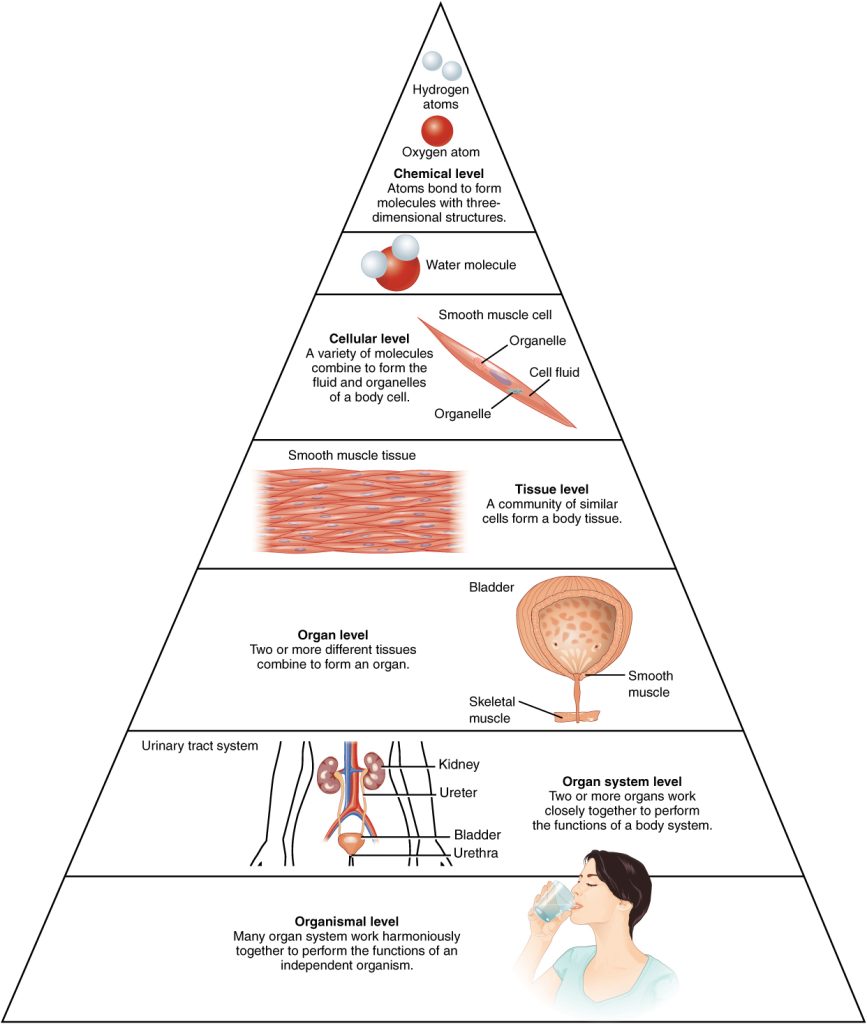
The third theme will be the hierarchical organization of body parts. You can think of the body’s components as being organized into a hierarchy of levels. Like all things in the physical world, your body is built from chemical building blocks. The smallest of these building blocks are atoms of elements, which combine to form larger and more complicated structures called molecules. These molecules, such as water, proteins, carbohydrates, nucleic acids, and lipids, are used to build cells. Cells are the smallest unit of organization capable of carrying out all life processes. Groups of related cells that work together to perform specific functions make up tissues, and tissues that work together form organs. Organs do not work independently; they are organized into organ systems that complete more complex tasks. How can you identify hierarchical organization? This type of structure is characterized by the following:
- Each level is made of parts from the level below.
- Complex structures are built out of simpler parts.
- Simple structures can be combined in many different ways.
What are the results of hierarchical organization?
- Each new level of organization has characteristics that were not present in the level below. These are called emergent properties. An emergent property is a new feature that arises from combining structures from the level below. For example, Sodium is a silvery, soft, explosive metal. Chlorine is a poisonous green gas. When sodium and chloride combine, table salt is created. Table salt is neither silvery nor green, neither explosive nor poisonous. Table salt is made only of sodium and chloride but has emergent properties (such as making french fries taste delicious) that are not present if the two chemicals are separate.
- Within a level, when the same parts are organized in a different way, differences in function are created. Changing how the elements of a level are organized generates different functions. Consider the digestive system as an example. The function of the digestive system is to bring food into the body and break it down physically and chemically into nutrients that our bodies can use. The digestive system includes the mouth, stomach, intestines, among others. Imagine the result if the order of organs was different!
Understanding this hierarchy is important because disruptions might occur at any level. For example, the depletion of calcium atoms from the body can lead to weak bones. Or a single mutation in a DNA molecule can lead to organ dysfunction, such as the disturbed lung function found in individuals with cystic fibrosis. In fact, disturbed function at higher levels in the hierarchy can be traced to disordered structure at the cellular and molecular levels.
Learn By Doing 1.3
Think about your experience of the world. Give an example of the hierarchical organization of a complex structure from outside biology.
4. Integration of Systems

Have you ever played a game of Jenga, where you try to remove one block at a time from a tower structure without causing the entire tower to collapse? In this game, each block depends on the other blocks for stability, and if you’re not careful, removing a single block can destroy the entire structure. Life is much the same. The various parts of living systems are interdependent at levels from the individual to the biosphere. The Merriam-Webster Dictionary defines interdependence as 1: the state of being dependent upon one another and 2: a mutually dependent relationship.
Your trillions of cells are intimately dependent on each other for survival. Your cells are specialized, and you exist because of a massive team effort from all these different cells. If any one of your major organs were to fail suddenly, you might die very quickly. Moreover, your health also depends on trillions upon trillions of bacterial cells that live in and on your body. They provide your cells with vitamins, help keep out invaders, and may even influence your mood. So your body itself is a community of interdependent cells.
Each section of the course will discuss the integration of the body’s systems. Every organ system relies on the healthy functioning of other systems to carry out its functions. When these systems all work together, the organism thrives. A breakdown in one system can cause failures in other systems as well.
Learn By Doing 1.4
Describe an example of interdependence among cells within your body.
Vital Functions for Human Life
Learning Objective
This section introduces you to the major organ systems of the body. To put these systems in context, we will first discuss the vital functions of life.
Within any organism, there is a multitude of functions taking place at any given time. Humans, for example, can breathe, talk, digest food, process visual images, and move their bodies simultaneously. While these activities are important, some are essential to the human body’s survival. They are vital functions– processes or actions of the body on which life is directly dependent. You will examine five vital functions in this course: control and regulation, structure, support, and movement; exchange with the environment; transport within the body; and protection from the environment.
Learn By Doing 1.5
Think about your own body and its many functions. Which functions are essential? What functions does your body need to perform each day to survive?
Hint: Think about what your body needs to survive and function properly. All multicellular systems must perform the same vital functions.
As we said, you will examine five vital functions in this text: control and regulation; structure, support, and movement; exchange with the environment; transport within the body; and protection from the environment. All multicellular systems must perform the same vital functions. Since the human body is a complex organism, we need to bring energy into our bodies, move materials throughout our bodies, move ourselves to new energy sources and regulate all of the complex stuff in our bodies.
So what does this mean? What does this involve? How does the human body do these things? Try answering the questions below to begin broadly thinking about body function within these categories and how they are linked to one or more primary organ systems.
Did I Get This? 1.1
Which of the following concepts would be classified as vital functions of human life?
- fluid transport within the body, and control and regulation
- homeostasis and structure and function
- the nervous system and the cardiovascular system
- the cell is the basic unit of life
Major Organ Systems of the Body Grouped by Primary Function
| Function | Organ System |
| Control and Regulation | Nervous and Endocrine Systems |
| Structure, Support, and Movement | Skeletal and Muscular Systems |
| Exchange with the Environment | Digestive and Respiratory Systems |
| Fluid Transport within the Body | Cardiovascular and Lymphatic Systems |
| Protection from the Environment | Integumentary and Lymphatic/Immune Systems |
Next, we will describe each major category of function and the systems that execute the vital functions. An organ system is an integrated collection of organs in the body that work together to perform a vital function. This course will organize the organ systems of the body based on the vital functions defined earlier. Keep in mind, however, that most systems of the body could be placed in more than one category. The major organ systems of the body and their primary functions are shown in Table 1.1.
Control and Regulation
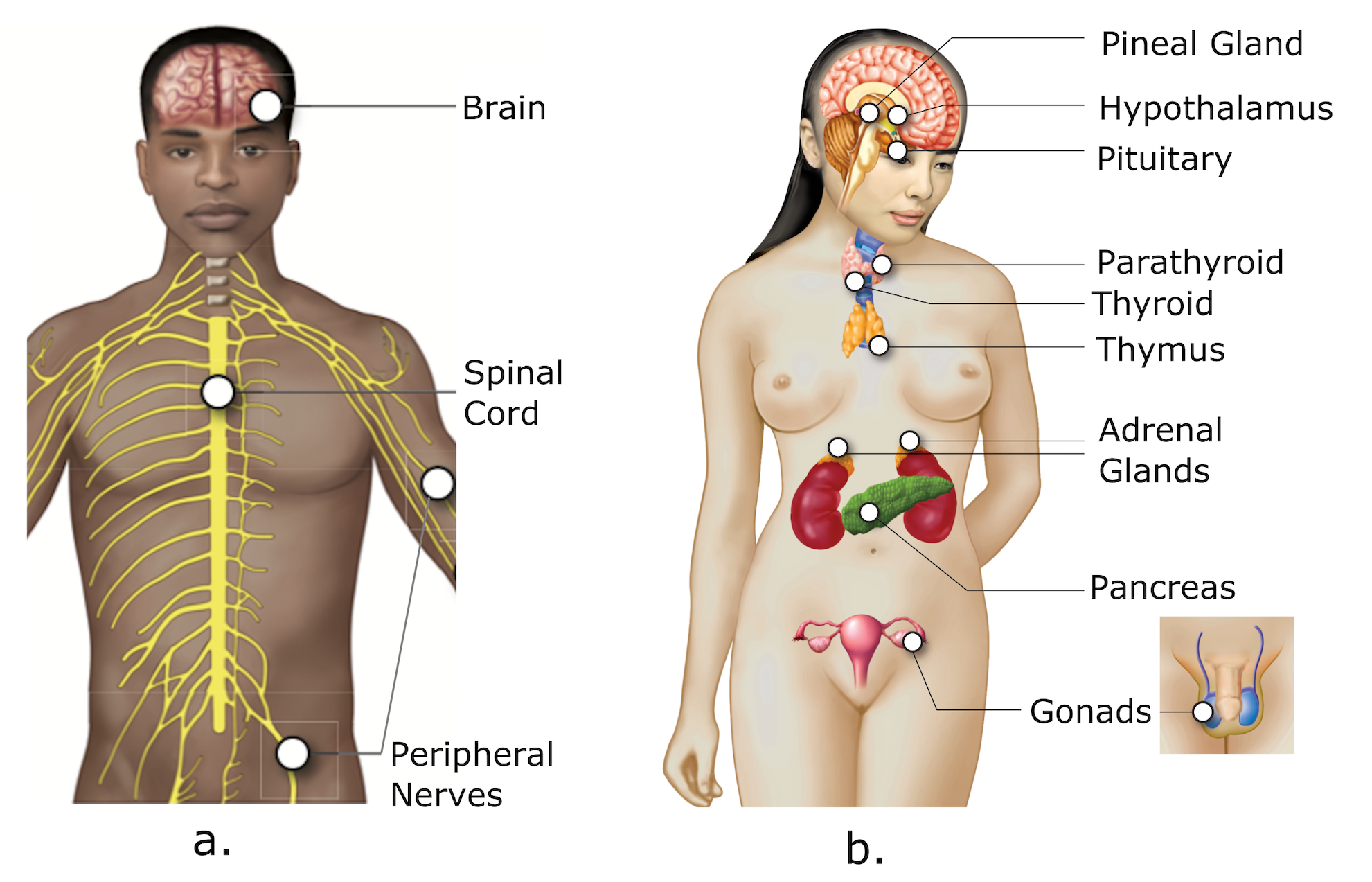
An organism must constantly gather information and react accordingly to maintain its internal equilibrium. In humans, the nervous system is made up of the brain, nerves, and spinal cord. Sensory organs react to environmental stimuli and signal other systems when actions are needed to bring the body back into balance. The endocrine system, which produces hormones and other regulatory substances, plays a crucial role in maintaining balance among chemical messengers within the body. Locally, most body cells can produce chemical messages that influence the metabolism of other cells. And some organs in other body systems produce chemicals that can travel through the body to regulate metabolic processes in other organs.
Structure, Support, and Movement
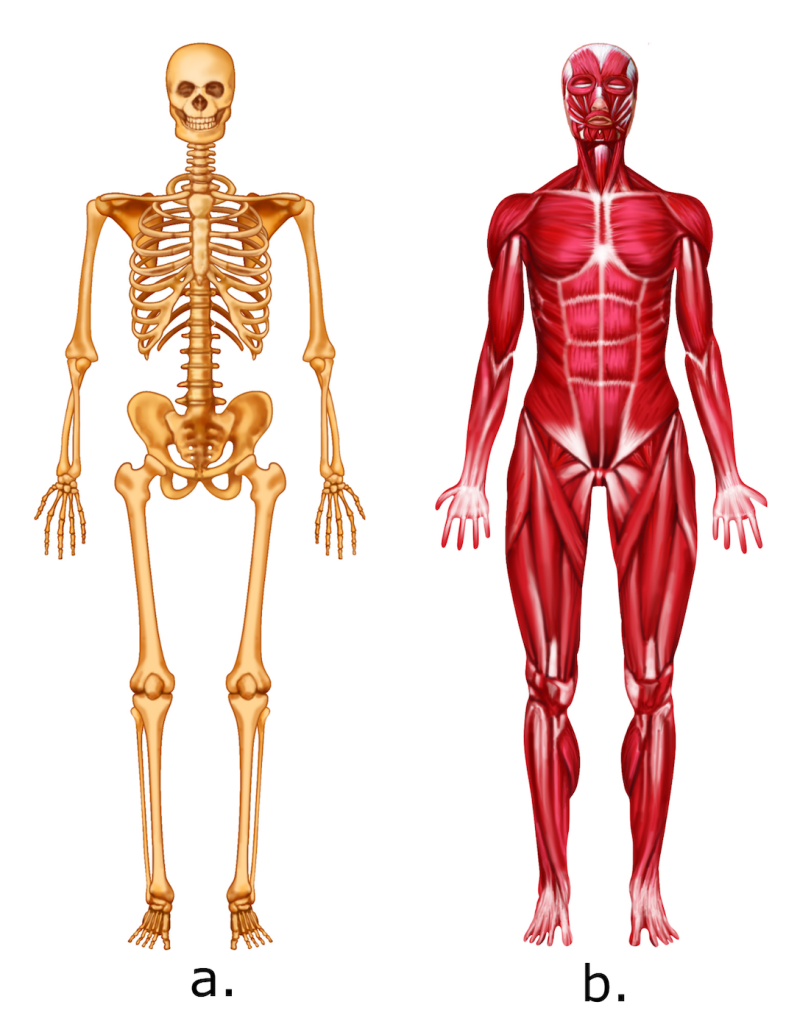
The skeletal and muscular systems support the body and allow it to move away from danger, toward food sources, etc. Certain parts of the skeletal system, such as the skull and ribcage, also help to protect the internal organs, such as the brain, heart, and lungs, from damage. The muscular system also allows for movement within the body.
Exchange with the Environment
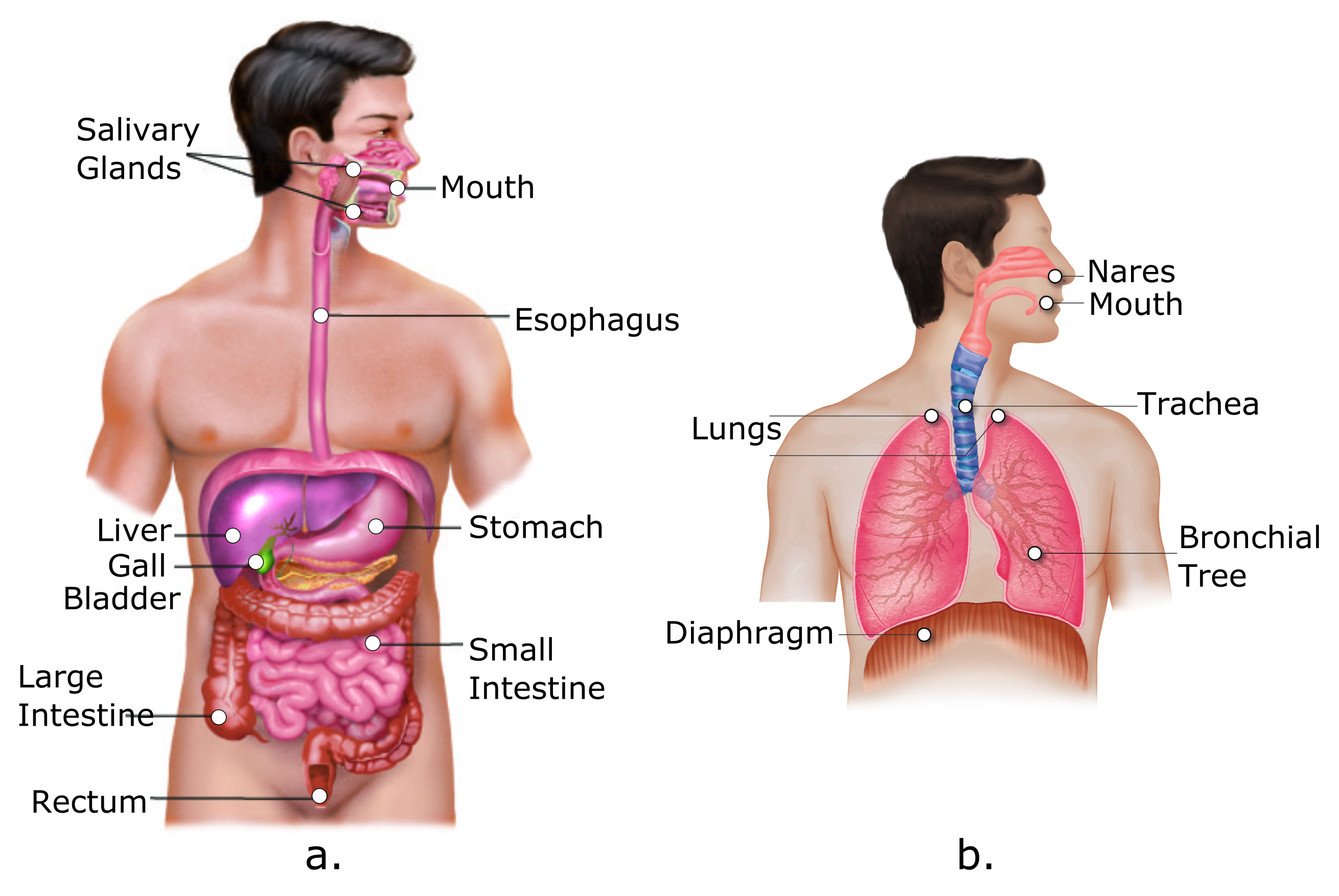
An organism constantly interacts with its environment. Our bodies must obtain food, water, and oxygen from the world to survive. The human body must also eliminate waste before it reaches toxic levels. Two organ systems are primarily responsible for exchanging material with the environment. The digestive system brings food and water into the body and eliminates solid wastes. The respiratory system brings in oxygen and removes carbon dioxide.
The urinary system doesn’t take in anything from the environment but does eliminate waste products of metabolism from the body fluid. However, this is just one of several roles that the urinary system plays in maintaining homeostasis of body fluids, so we will explore it more extensively in the following vital function category involving body fluids.
Fluid Transport within the Body
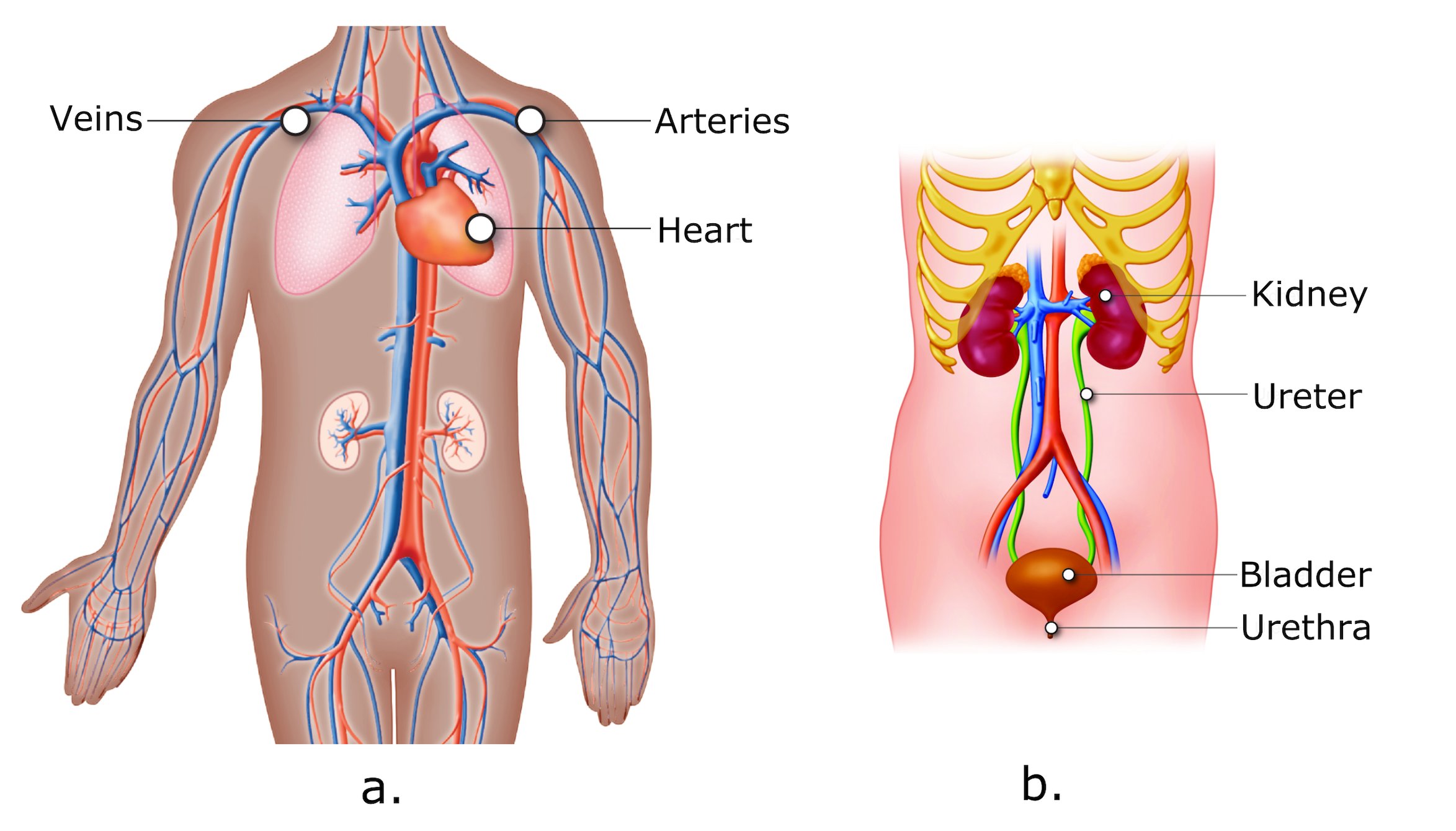
Single-celled organisms can directly absorb nutrients and oxygen from the environment into themselves, which they use to support essential cell functions. Single-celled organisms excrete waste products in a similar fashion. In multi-celled organisms like humans, however, most cells are not exposed directly to the outside environment. Instead, body cells rely on organ systems to transport and regulate the composition of internal fluids throughout the body. The cardiovascular system provides the “pipes” that carry blood and a pump that pushes blood. The lymphatic system returns interstitial fluid to blood. This system also participates in immune function and so will be discussed in the next section. The urinary system filters blood to regulate body fluid homeostasis, including volume, pressure, and chemical composition.
Protection from the Environment

Our organs must be protected from potentially damaging environmental substances, including pathogens (disease-causing microorganisms). The integumentary system forms the immune system’s first line of defense. It is made up of skin, hair, and nails. Our skin, and mucous membranes that line body cavities in contact with the environment, prevent most pathogens from entering the body and destroying healthy body cells. Organs of the lymphatic system provide the many roaming cells of the immune system with a home base. These cells, and the molecules they produce, defend us from foreign organisms that manage to enter our body tissues or fluids.
Learn By Doing 1.6
How does the body exchange with the environment? Indicate (yes or no) whether or not the functions below help the body exchange with the environment.
- Breathing?
Hint: Exchange with the environment involves everything that goes in and out of the body. - Heart Beating?
Hint: Exchange with the environment involves material going in or out of the body, not the transport of those items within the body. - Defecation?
Hint: Exchange with the environment involves everything that goes in and out of the body. - Eating and drinking?
Hint: Exchange with the environment involves everything that goes in and out of the body.
What has to move or flow through the body? Indicate (yes or no) which materials are transported throughout the body.
- Water?
Hint: Blood flows through the body. What is the primary fluid component of blood? - Nutrients?
Hint: Materials needed throughout the body that come in at one location are transported through the body. - Muscles?
Hint: Do muscles flow throughout the body? - Oxygen?
Hint: Body processes need food and oxygen, which we get from the environment. These processes also produce waste. - Waste products?
Hint: Wastes are produced throughout the body and need to travel to places of processing before they can be excreted into the environment.
What structure(s) is/are directly responsible for helping you stand up straight? Indicate (yes or no) whether the items below help do this as part of the vital functions of providing structure, support, and protection.
- Lungs?
Hint: Think of the parts of your body needed to lift something. - Bones?
Hint: Think of the parts of your body needed to lift something. - Stomach and intestines?
Hint: The digestive system brings nutrients into the body and removes undigested food. - Muscles?
Hint: Think of the parts of your body needed to lift something.
What is the most important regulator and coordinator of multiple functions in the body?
Hint: We consciously or unconsciously control most of our body functions with this organ.
- stomach
- bones
- heart
- brain
- eyes
Which of the following protects our bodies from the environment? Choose all that are correct.
Hint: Consider what things our bodies must be protected against.
- red blood cells
- white blood cells
- internal body cavities
- skin
- lymph nodes
- mucous membranes
As you can see, several organ systems work together to accomplish vital functions throughout the body. Since the organ systems are distributed throughout large regions of the human body, it is necessary to define orientation within the body and communicate the proper terminology as you study these integrated structures and functions.
*
“Learn By Doing” and “Did I Get This?” Feedback
Learn By Doing 1.1
- In your own words, describe how structure and function are related.
Put simply, the way something is built–the form it takes–determines its ability to perform a given task. We often say “Structure equals function.” - Think about your experience of the world. Give an example of the relationship between structure and function from outside biology.
Cooks use a variety of pots and pans; these come in a range of shapes and sizes. A tall, large pot is well-suited to cooking 2 pounds of pasta but not to frying an egg. Similarly, construction workers use a variety of tools; these come in a range of shapes and sizes. A hammer is well-suited to drive a nail into a board but would not work to tighten a bolt. Both of these examples demonstrate that the way something is structured determines its ability to perform a specific function.
Learn By Doing 1.2
Diabetes Mellitus is a set of metabolic diseases wherein the body either does not produce enough of the hormone insulin or cells do not respond to the insulin that is produced. This results in high levels of sugar (glucose) in the blood. Diabetes Mellitus results from an inability to properly control the homeostasis of what?
- insulin levels
Not quite. The amount of insulin itself is not necessarily the problem. Sometimes there is enough insulin, but the body cannot use it properly. Insulin levels usually control blood glucose levels, but it is blood glucose levels being out of the homeostatic range that causes problems in untreated diabetes. - blood pressure
No: Although blood pressure is a homeostatically controlled variable, it is not the problem in diabetes. - blood glucose levels
Yes: The body tries to keep blood glucose levels between 90 and 100 mg/dl (milligrams per deciliter), but in untreated diabetes, it can be much higher than this. - blood flow
No: Blood contains sugar, but the flow is not the culprit in this condition.
Learn By Doing 1.3
Think about your experience of the world. Give an example of the hierarchical organization of a complex structure from outside biology.
Imagine a building (top level) made of bricks, glass, and wood (all second level). Bricks are made of clay, sand, lime, iron oxide, and fly ash (fine particles of burned fuel), and water (third level). Clay itself is composed of tiny particles of weathered rocks. Clays contain kaolinite, montmorillonite-smectite, and illite minerals (fourth level). Kaolinite contains atoms of the elements oxygen, silicon, hydrogen, and aluminum (fifth level).
Learn By Doing 1.4
Describe an example of interdependence among cells within your body.
Our answer: There are many good answers. Your brain cells depend on freshly oxygenated blood flow, so if your lungs or heart stop functioning, your brain cells will die within several minutes. On the other hand, your lungs and heart work partly under the control of signals from your brain. You cannot digest food properly or make specific vitamins without help from bacteria in your gut, and these, in turn, depend on your body as a warm, nutrient-rich place to grow. Whatever example you came up with should have this sense of a two-way interaction: the cells are mutually dependent on one another.
Learn By Doing 1.5
Think about your own body and its many functions. Which functions are essential? What functions does your body need to perform each day to survive?
Our answer: Your body performs many unique and interconnected functions that contribute to at least one of the following: 1. Exchanging material with the environment; 2. Transporting fluids and materials within the body; 3. Structure, support, and movement; 4. It regulates and controls processes; and 5. Protecting us from the environment
Did I Get This? 1.1
Which of the following concepts would be classified as vital functions of human life?
- fluid transport within the body, and control and regulation
Yes: These are two of the body’s vital functions. Exchange with the environment and structure, support, and movement are also vital functions. - homeostasis and structure and function
No: Homeostasis and structure and function are important organizational themes, but they apply to all of the various vital functions in the human body. - the nervous system and the cardiovascular system
No: These are organ systems that function to perform vital functions, not independent vital functions. - the cell is the basic unit of life
No: Recognizing the cell is the basic unit of life is one of the big ideas in physiology, not a vital function.
Learn By Doing 1.6
How does the body exchange with the environment? Indicate (yes or no) whether or not the functions below help the body exchange with the environment.
- Breathing?
Yes: Although you cannot see an exchange taking place, breathing allows us to bring in oxygen and expel waste (carbon dioxide). - Heart Beating?
No: Although the heartbeat drives the transport of materials exchanged by the respiratory and digestive systems into or out of the blood, this body function does not directly participate in the exchange. - Defecation?
Yes: Exchanging with the environment includes getting rid of waste. Defecation removes solid, undigested waste from the digestive system. - Eating and drinking?
Yes: Both eating and drinking bring materials into the body.
What has to move or flow through the body? Indicate (yes or no) which materials are transported throughout the body.
- Water?
Yes: Water is a solvent used to carry materials through the body. - Nutrients?
Yes: Nutrients are needed to support a variety of functions throughout the body. - Muscles?
No: While muscles shorten and lengthen, muscles do not flow and are not transported through the body. - Oxygen?
Yes: Red blood cells carry oxygen through the body to help metabolize materials inside the body’s tissues. - Waste products?
Yes: The body produces wastes, which need to be transported to centers of processing and excretion.
What structure(s) is/are directly responsible for helping you stand up straight? Indicate (yes or no) whether the items below help do this as part of the vital functions of providing structure, support, and protection.
- Lungs?
No: Although the lungs bring in oxygen needed throughout the body, it is not directly responsible for you standing up straight. - Bones?
Yes: Bones provide the physical structure needed to stand up straight. - Stomach and intestines?
No: Although the digestive system brings in nutrients needed by the body, it is not directly responsible for you standing up straight. - Muscles?
Yes: Muscles provide the force needed to maintain a straight posture.
What is the most important regulator and coordinator of multiple functions in the body?
- stomach
No: The stomach plays an important part in regulating the digestive system but does not regulate multiple functions within the body. - bones
No: Bones do participate in homeostasis but do not regulate multiple body functions. - heart
No: The heart is essential for transporting nutrients needed in a variety of processes but does not regulate multiple functions within the body. The nervous and endocrine systems help regulate the cardiovascular system function. - brain
Yes: We use the brain to process information and control bodily functions consciously (by making decisions) and unconsciously (with automated processes). - eyes
No: Eyes help us interact with the environment but do not regulate multiple body functions; we must process this sensory information consciously (by making decisions) and unconsciously (with automated processes) to affect other systems.
Which of the following protects our bodies from the environment? Choose all that are correct.
Hint: Consider what things our bodies must be protected against.
- red blood cells
No: Red blood cells are responsible for oxygen transport. - white blood cells
Yes: White blood cells, and the molecules they produce, defend us from fpathogens that manage to enter our body tissues or fluids. - internal body cavities
No: Internal body cavities are not in contact with the outside environment. - skin
Yes: Skin acts as a barrier that protects us from pathogens, mechanical and chemical trauma, and dehydrating environments. - lymph nodes
Yes: Lymph nodes are one location where white blood cells called lymphocytes are presented with molecules that come from pathogens. These pathogen-derived molecules allow lymphocytes to target pathogens and to spare our own cells. - mucous membranes
Yes: Mucous membranes line the body cavities in contact with the outside world. Similar to skin, they act as barriers to pathogens and protect underlying tissues from mechanical and chemical trauma.
Media Attributions
- Levels of Organization in the Human Body
- Jenga
- nervous and endocrine © KnowledgeWorks Global Ltd. is licensed under a CC BY-NC-SA (Attribution NonCommercial ShareAlike) license
- skeletal muscular © Open Learning Initiative, Carnegie Mellon University is licensed under a CC BY-NC-SA (Attribution NonCommercial ShareAlike) license
- Exchange with Environment
- fluid in body © KnowledgeWorks Global Ltd. is licensed under a CC BY-NC-SA (Attribution NonCommercial ShareAlike) license
- Protection © KnowledgeWorks Global Ltd is licensed under a CC BY-NC-SA (Attribution NonCommercial ShareAlike) license
